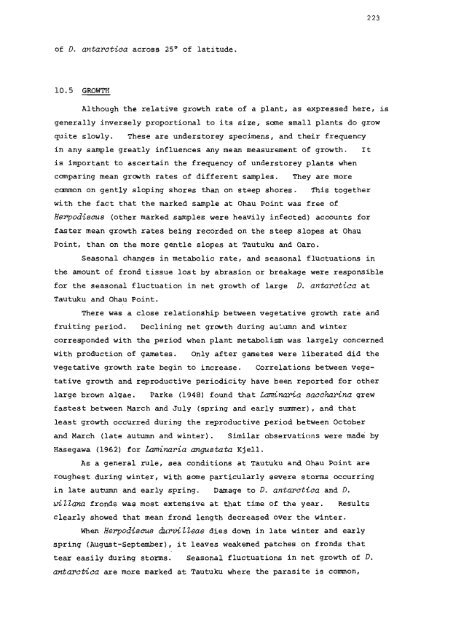A biological study of Durvillaea antarctica (Chamisso) Hariot and D ...
A biological study of Durvillaea antarctica (Chamisso) Hariot and D ...
A biological study of Durvillaea antarctica (Chamisso) Hariot and D ...
You also want an ePaper? Increase the reach of your titles
YUMPU automatically turns print PDFs into web optimized ePapers that Google loves.
223<br />
<strong>of</strong> D.<br />
antaratiaa across 25° <strong>of</strong> latitude.<br />
10.5 GROWTH<br />
Although the relative growth rate <strong>of</strong> a plant, as expressed here, is<br />
generally inversely proportional to its size, some small plants do grow<br />
quite slowly. These are understorey specimens, <strong>and</strong> their frequency<br />
in any sample greatly influences any mean measurement <strong>of</strong> growth. It<br />
is important to ascertain the frequency <strong>of</strong> understorey plants when<br />
comparing mean growth rates <strong>of</strong> different samples. They are more<br />
cammon on gently sloping shores than on steep shores. This together<br />
with the fact that the marked sample at Ohau Point was free <strong>of</strong><br />
HeppodiacuB (other marked samples were heavily infected) accounts for<br />
faster mean growth rates being recorded on the steep slopes at Ohau<br />
Point, than on the more gentle slopes at Tautuku <strong>and</strong> Oaro.<br />
Seasonal changes in metabolic rate, <strong>and</strong> seasonal flUctuations in<br />
the amount <strong>of</strong> frond tissue lost by abrasion or breakage were responsible<br />
for the seasonal fluctuation in net growth <strong>of</strong> large D. antarotiaa at<br />
Tautuku <strong>and</strong> Ohau Point.<br />
There was a close relationship between vegetative growth rate <strong>and</strong><br />
fruiting period. Declining net growth during au~umn <strong>and</strong> winter<br />
corresponded with the period when plant metabolism was largely concerned<br />
with production <strong>of</strong> gametes. Only after gametes were liberated did the<br />
vegetative growth rate begin to increase. Correlations between vegetative<br />
growth <strong>and</strong> reproductive periodicity have been reported for other<br />
large brown algae. Parke (1948) found that Laminaria sacaharina grew<br />
fastest between March <strong>and</strong> July (spring <strong>and</strong> early summer), <strong>and</strong> that<br />
least growth occurred during the reproductive period between October<br />
<strong>and</strong> March (late autumn <strong>and</strong> winter) . Similar observations were made by<br />
Hasegawa (1962) for Laminaria anguBtata Kjell.<br />
As a general rule, sea conditions at Tautuku <strong>and</strong> Ohau Point are<br />
roughest during winter, with some particularly severe storms occurring<br />
in late autumn <strong>and</strong> early spring. Damage to D. <strong>antarctica</strong> <strong>and</strong> D.<br />
wiZ,Z,ana fronds was most extensive at that time <strong>of</strong> the year. Results<br />
Clearly showed that mean frond length decreased over the winter.<br />
When HeppodiBCUB durviZ~eae dies down in late winter <strong>and</strong> early<br />
spring (August-September), it leaves weakened patches on fronds that<br />
tear easily dUring storms. Seasonal fluctuations in net growth <strong>of</strong> D.<br />
antaPctiaa are more marked at Tautuku where the parasite is common,
















